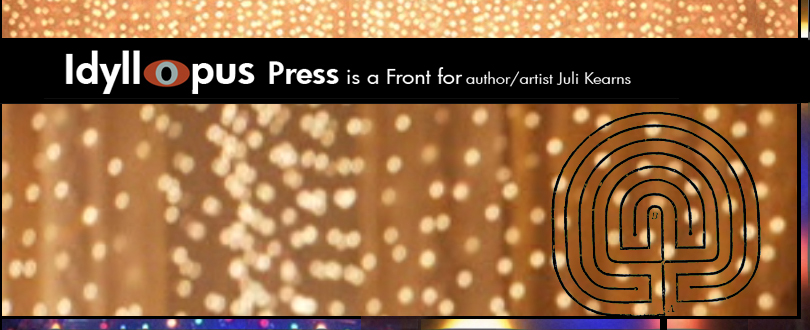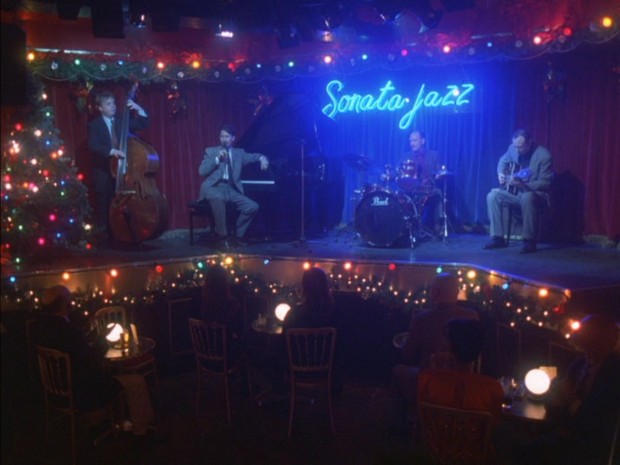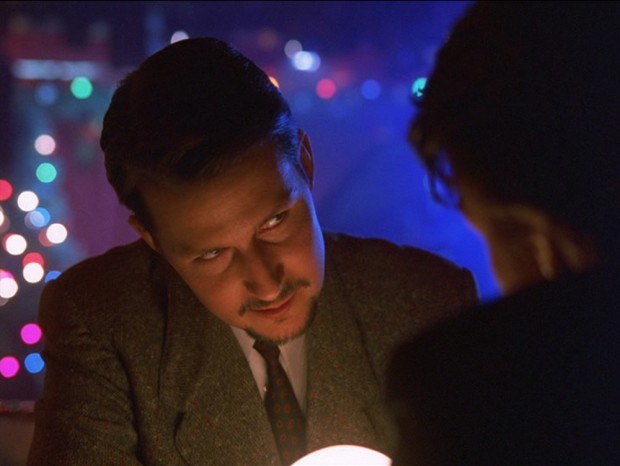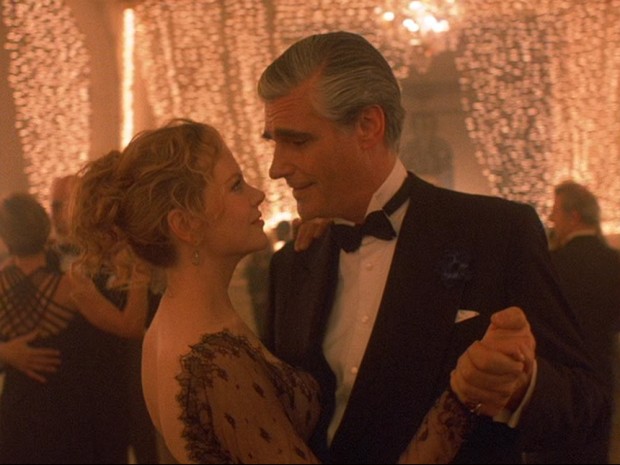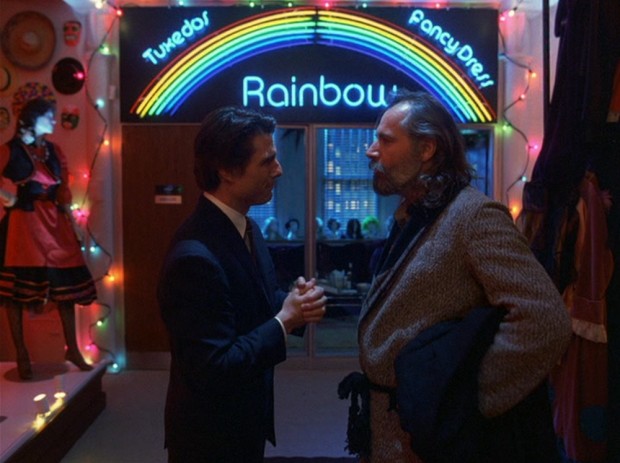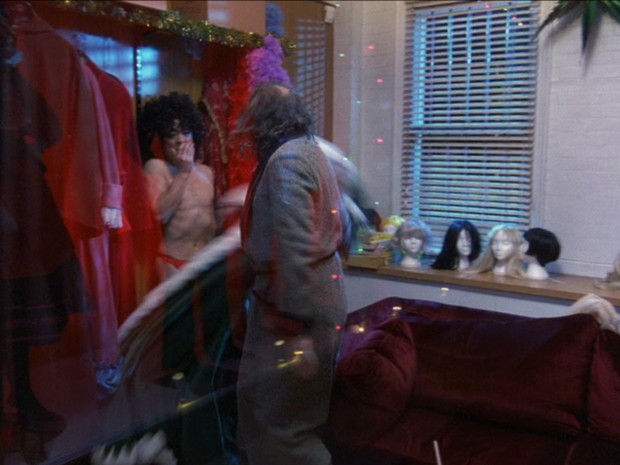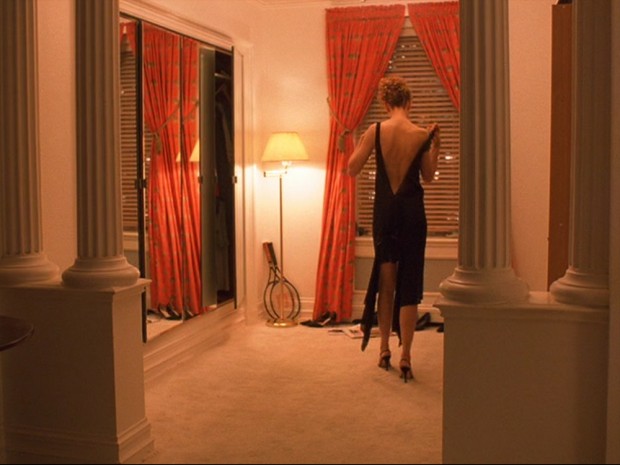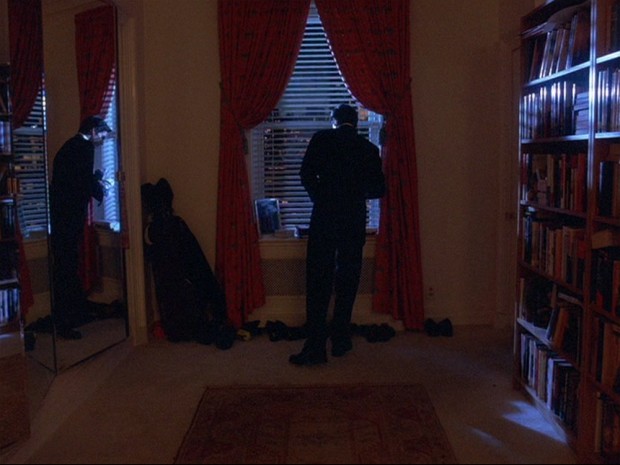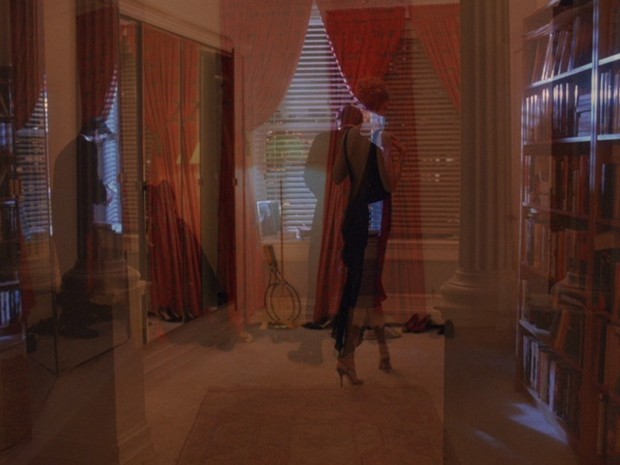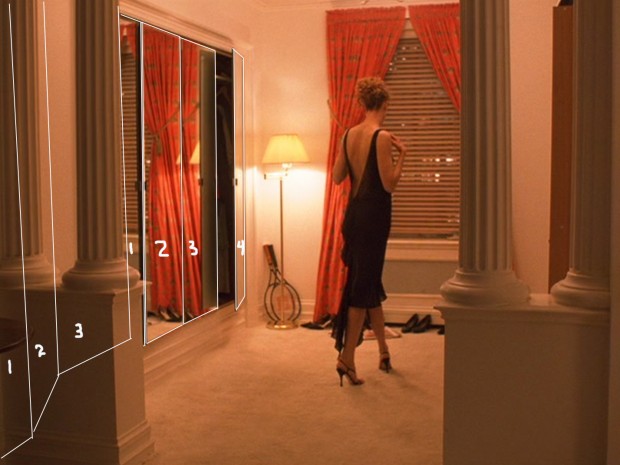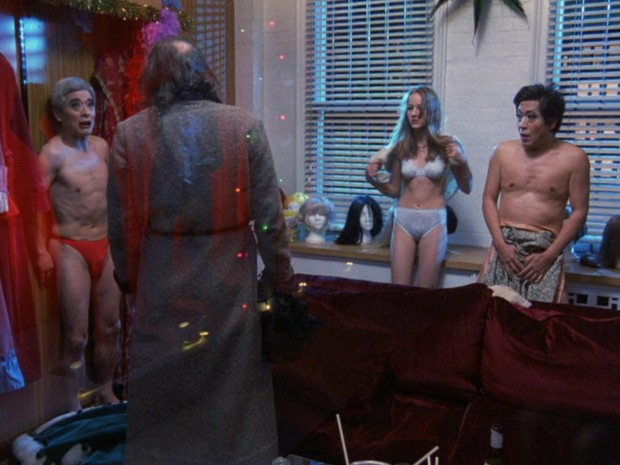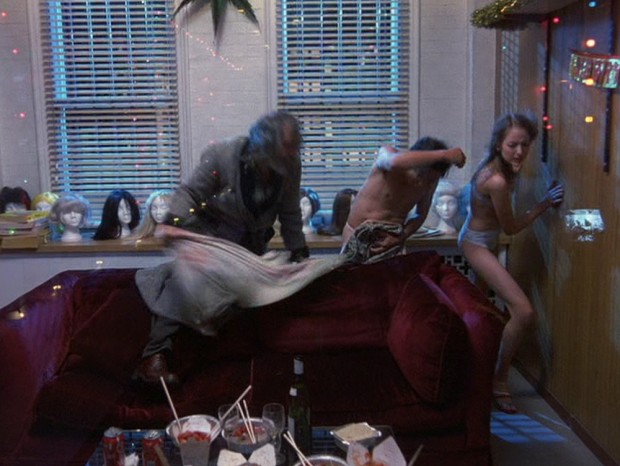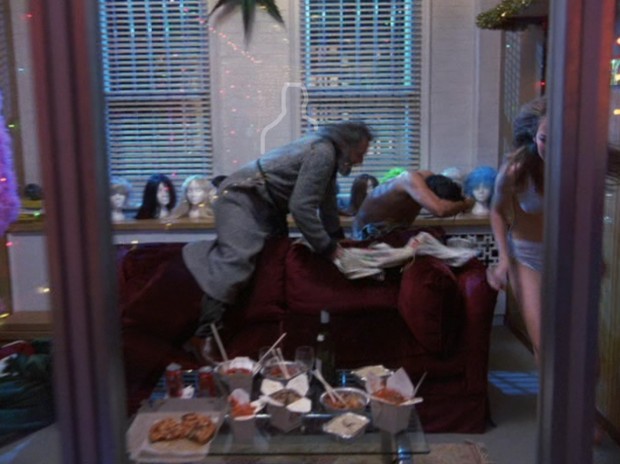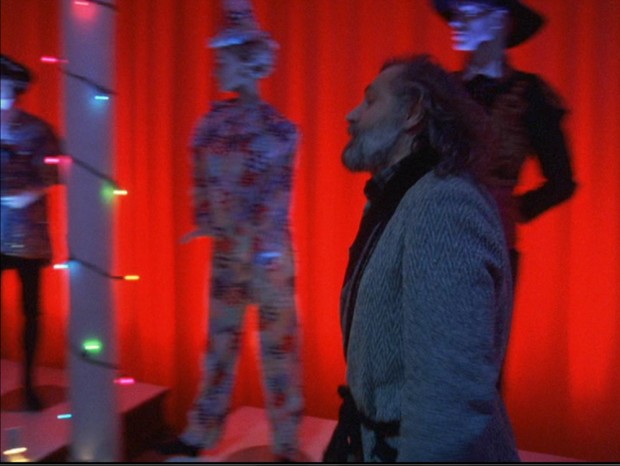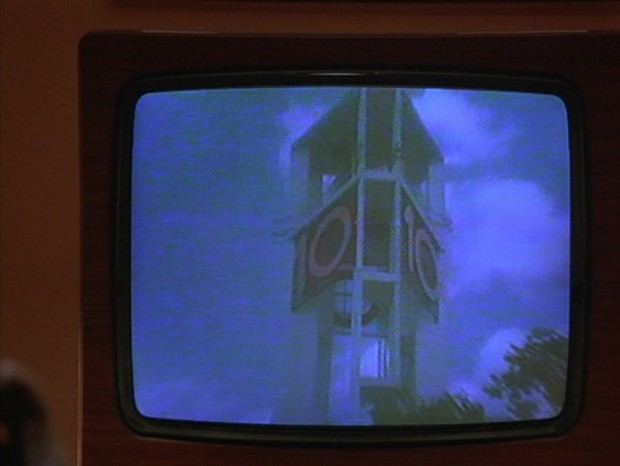STANLEY KUBRICK'S EYES WIDE SHUT

Go to TOC for this film ( (which has also a statement on purpose and manner of analysis and a disclaimer as to caveat emptor and my knowing anything authoritatively, which I do not, but I do try to not know earnestly, with some discretion, and considerable thought).
PART FOUR
TOC and Supplemental Posts | Part 1 | Part 2 | Part 3 | Part 4 | Part 5 | Part 6 | Part 7 | Part 8 | Part 9 | Films Home
LINKS TO SECTIONS OF THE ANALYSIS ON THIS PAGE:
Bill's Fourth Pass Through the Neighborhood, Shots 195 through 231
The Sonata Jazz Cafe. Comparison with the happenings at the Sonata with the Duke of York in A Clockwork Orange. The marquee and possible references to Gayle and Nuala. Night train. All exits are final. Fidelio. St. Nick, Nike, or Old Nick? Shining eyes.
Bill's Fifth Pass through the Neighborhood, Shots 232 through 259
Rainbow Fashions as Victor's second floor gallery of bronze Renaissance statues. "Looks like live" mannequins. The two versions of the dressing room closet at the Harford apartment as expressed in the Rainbow office where is also the Harford's rug. The myth of the rainbow, the flood and the mighty men of old.
Black and White
And Inbetween
Milton Keynes
A handy-dandy diagram I made up of the streets Bill rambles and the various establishments he visits which are actually multiple fronts.
BILL'S FOURTH PASS THROUGH THE NEIGHBORHOOD
THE SONATA JAZZ CAFE - COMPARISON WITH THE HAPPENINGS AT THE SONATA WITH THE DUKE OF YORK IN A CLOCKWORK ORANGE - THE MARQUEE AND POSSIBLE REFERENCES TO GAYLE AND NUALA - NIGHT TRAIN - ALL EXITS ARE FINAL - FIDELIO - ST. NICK, NIKE OR OLD NICK? - SHINING EYES
SKIP ALL THIS AND TAKE ME TO THE TL;DR WRAP-UP AT THE END OF THE PAGE.
195 MS Bill passing by Mancini's. (54:48)
Back out on the street. Bill passes by a restaurant and Mancini's cheese shop which is numbered 11 (I read that the name Mancini's origin is from a word meaning "left handed", and this has been the screen left hand side of the "rainbow" street until now). Bill passes another man on a pay phone, this one in a red jacket, then James Tobias Lomas Inc. Rentals (real estate), numbered 7.
That 7 attracts attention because of the painting back at Bill's practice, which has in it the number 7.
As Bill has passed the man on the phone, the woman of the couple walking by can be heard saying, "Sexual playground."
Once again, all the background voices are muted and mixed in such a way that it is impossible to make out what they are saying, then will come along a few choice words that make it past that muted censorship. At Victor's party, we'd heard a woman say, "To another bed." When Bill was passing a man on a phone, before meeting Domino, we'd heard the man say, "Oh, I see, I'm taking care of it, baby." We'd heard the "No, no!" response to Domino's asking if that was Mrs. Bill, to which Bill had replied, "Yes, yes," and now the environment audibly pipes up again and announces, "Sexual playground", as Bill passes James Tobias Lomas Rentals and is about to come upon the Sonata where he will get the password to the orgy from Nick.
This James Tobias Lomas, Inc. realty office is a peculiar entity, fashioned to stand out. It's a sub street level office, and I believe the only other sub street level shop we observe is one below Rainbow Fashions, which is obviously a part of it but we see no entrance to it from inside the upper level Rainbow Fashions shop.
With the Lomas storefront we have the same green as had at Domino's, the Nipped in the Bud shop, and the elevator at Marion's. Bill's glance at the building calls our attention to it, a storefront that will remain a question mark, Kubrick calling our attention to it for no known reason.
Next, he passes Gillespie's Diner. Beside Gillespie's Diner he sees the Sonata Cafe at street number 3.
Decorative elements on the Sonata Cafe's building include diamonds. In A Clockwork Orange, the Duke of York pub was liberally decorated with diamond elements, and it was here that Alex, having manhandled his droogies so that he was in the dominant position again, insisted upon being told what the break-in for that night was that his droogies had originally planned, and after appearing to be reluctant to provide him the information, he was told the location. This led to his fateful encounter at the Cat Woman's where he was momentarily blinded and caught by the police. We have a similar formula here where Bill will acquire the password, Nick will be reluctant to give him more info, Bill will persist, and then Nick will tell him what he needs to know to get into the party--though not what he needs to know not to be found out and get in a good deal of trouble.
A sign is above the Sonata cafe of a neon guitar with its neck pointed to the right. Now there walks into the scene a man from the left carrying a guitar case which doubles the sign, and this man with the guitar case continues on. When Bill later returns to the Sonata, again an individual will pass carrying a guitar. So again we pointedly have the doubling, a sign then being physically represented. The symbol precedes "real life".
Sonata comes from a word that means "singing", which could have some correspondence to the name, Nick Nightingale. But I wonder if we may find in Sonata a reference to the Hebrew word ShNH and doubling, a subject I've covered in The Shining as I believe it may related to that film. Perhaps, for this reason, the guitars doubling the neon.
On the awning, below the cafe's name, is a downward swoop of a stylized exclamation point or falling star/meteor with trail symbol. Kubrick twice fit what resembles an exclamation point (mirrored) into the psychedelic light scene in the beyond the infinite ride Bowman takes upon finding the monolith at Jupiter. And, if one thinks about it, the atmosphere of the Sonata with its bright lights and the series of globes on the tables, as if expressing an endless mirroring, may bring to mind Bowman's adventure.
In the above screengrab, note the woman in the tan coat and hat who passes by. Look to shot 177. A similarly attired woman passes by Domino's building as Bill enters it. In shot 455, a woman who reminds of these other two exits Domino's building as Bill arrives a second time.
Hearing piano, Bill stops and steps up to look at the marquee, the doorman discretely eyeing him.
196 Bill approaching the marquee. (55:15)
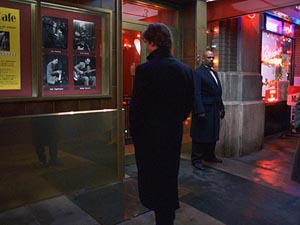 196 |
 197 |
 198 |
|
197 CU Nick Nightingale's picture on the marquee. (55:23)
We view from behind Bill's left shoulder Nick Nightingale's photo on the marquee, he looking directly at Bill. To the left we see a part of Nick's name on a yellow sheet of paper that reads:
...ET
...NGALE
...:30
...MENDED (or ENDED as part of the M is cut off)
Jan 5 - 9
Jan 12 - 26
Jan 5 - 9
There are some other things I can't quite make out at the bottom of the yellow poster.
Other pictures on the marquee include Kip Fleming on bass, Bobby Berman on guitar, and Larry McVey playing Pearl drums.
The "mend" may draw notice as at the end of the street in some shots we have the thread mills sign and at one point under that we have an auto repair sign, and mend of course does mean to repair. Near the beginning of the movie, Roz, the babysitter, had a sewing kit of thread on the coffee table when Alice and Bill were leaving for the party (if that was indeed her kit). Which takes us back to the conversation between Nick and Bill when Bill said of himself that once a doctor, always a doctor, and Nick replied, as to himself, that never a doctor, never a doctor. Here we have "mend" in conjunction with Nick's name, perhaps the idea of repair, and if we look up the etymology for doctor? The etymology of that traces back to the idea of decency, to be fitting or suitable, which fits with Bill's character as someone who seems fundamentally decent and desires to seem eminently decent when he's not. But healing and mending are not associated with the broad title of "doctor".
If Nick functions in the film as a kind of covert healer, repairer, this may also be seen in the white jacket he wore at Ziegler's and which he will be wearing at Somerton, corresponding with the white jacket Bill wears when with his patients.
Recollect also the Band-aid box that had held the pot, which may also tie in with the band and idea of mending.
Because of his Mephistopholean character, one is predisposed to immediately identify Nick in that role, as in a devilish Nick, but there is the time of year to consider, making St. Nick apropos, a dispenser of gifts. A linking with St. Nick would also be interesting as St. Nicholas is the patron saint of sailors, and we have the naval officer in the film, also an implied flood in conjunction with the rainbow symbolism.
The cartoon observed earlier unites the character of the Tasmanian Devil with St. Nick, the devilish (Mephistopholean) idea and the gift giver.
The etymology of Nick comes from the Greek Nike and is thus "victory" which aligns him with Victor Ziegler. Where did Bill meet him but at Ziegler's?
If we hadn't caught it before, another connection could be seen as made here, via "gale", between Nick Nightingale and Gayle who had invited Bill to the end of the rainbow.
198 MS Profile of Bill looking at the marquee. (55:27)
As an individual with a very large Russian style hat passes by, Bill turns to enter the club. We hear strains of "Night Train". The train is an important theme in Kubrick's films and will appear later in this movie. (See this post for an exploration of the subject.) When Bill reads the paper on which is the "Lucky to be Alive" headline, the story of the model's overdose is surrounded by articles on a threat of violence on a subway train, and its similarity to the actual killing of several people on a subway train some years before.
BILL (to the doorman holding the door): Thank you.
Below is the exterior of Jojo's at 8-10 Brewer St. in London where the interior of the Sonata Jazz Cafe was shot.
199 MCU Bill descending the stairs into the underground club. (55:37)
Cut to Bill descending a red painted stairway that is lined with mirrors. As he turns a corner into the club proper, we see beyond him a sign on the wall that reads "Please present receipt when exiting" and another reads "All Exits Are Final." This echos Bill's abusers on the street shouting "exit only" when slapping their rears. When Bill attempts to return to the Sonata the next day the gate is closed to him, as will gates be closed to him in every situation he revisits. "All exits are final."
There's also a sign that states if one looks under 30 and plans to be drinking then be prepared to show ID that you are over 21.
A bill on the wall seems to read "Queen Ida". Jojo's was and still is a drag club. There are two performers by the name of Queen Ida to be found on the internet. "Queen Ida" is a Zydeco accordionist. But there is also Ida Slapter, a drag queen. A link could be that Ida means "working" or even "hardworking", and Bill had been invited on his journey to the rainbow with it being said he works too hard and misses much. But that doesn't seem quite right. Could be that Queen Ida's bill happened to be up at Madame Jojo's and Kubrick opted to leave it in place.
On the other hand, I have been endeavoring to show how Eyes Wide Shut has ties throughout it to the stories of Troy and Jericho, to the gods and goddesses and heroes and heroines of those legends, and one could divine here another connection. For what preceded Paris' judgment as to who should receive the Apple of Discord? Let's refer to Wikipedia:
Three goddesses claimed the apple: Hera, Athena and Aphrodite. They asked Zeus to judge which of them was fairest, and eventually he, reluctant to favour any claim himself, declared that Paris, a Trojan mortal, would judge their cases, for he had recently shown his exemplary fairness in a contest in which Ares in bull form had bested Paris's own prize bull, and the shepherd-prince had unhesitatingly awarded the prize to the god.
Thus it happened that, with Hermes as their guide, the three candidates bathed in the spring of Ida, then confronted Paris on Mount Ida in the climactic moment that is the crux of the tale. The goddesses appeared to Paris naked, the reason being controversial. While Paris inspected them, each attempted with her powers to bribe him...
At Victor's party, Alice's beauty had been praised by Victor, but then his wife, Illena (Helen), reveals that he tells all women they are as stunning.
Bill is about to be led further on in his adventure by the tantalizing promise of witnessing at a secret party women such as he has never imagined. The connotation being one of goddess-like beauty.
Another link to Troy is supplied by Minos, the king who had the Minotaur's labyrinth built. His mother was Ida, daughter of Corybas and wife of Lycastus.
In the below shot, the object behind Bill's head frames it in such a way where, briefly, he looks as if he has donkey ears. This is perhaps unintentional, but it reminds me of Pinocchio and how he gained donkey ears and a tail as a result of his falling in with characters of ill repute on Pleasure Island. Or this may not be accidental, considering how that story parallels the one here, and we would also have an anticipation of the film AI.
Entering the club proper, we see a bar on the left, above it photos of musicians, and a television playing a football game--perhaps the same game Bill and Alice had earlier been watching, a replay? He is greeted by the maitre' d who asks if he'd like a seat at the bar or at a table. He requests a table. He is shown to a seat at one of the tables, all of which are illuminated with a globe light in the middle that reminds a little of a crystal ball in which fortunes are told. The shot echoes the one in The Shining which shows the lit lamps on the tables in the Gold Room when Jack enters it after his dream and meets the spirit of the bartender by whose aid he falls off the wagon and indulges in spirits.
MAITRE'D: Good evening, sir. Would you like a table or would you like to sit at the bar?
BILL: I'd like a table.
MAITRE'D: Please, follow me.
MAITRE'D: Can I take your coat?
BILL (handing over his coat and sitting): Thank you.
MAITRE'D: Can I get you anything to drink?
BILL: I'd like a beer.
MAITRE'D: Certainly.
Bill hadn't needed to use his ID to enter Domino's building, though a sign called for a presentation of IDs. He hasn't needed to use an ID here. He will begin using his ID after he exits the Sonata.
200 MS Bill at his table. (56:16)

201 LS The band on stage. (56:18)
The band appears to be shutting down for the night though the sign outside reads music until 3.
NICK: One, two, one, two, three four...That's it for tonight, ladies and gentlemen. On the bass, Mr. Larry McVey. On the drums...
In the audience we see a large bald man who resembles the threatening bald man who will later follow Bill.
202 MS Bill clapping. (56:32)
NICK: ...Kip Fleming. And on the guitar...
203 LS The band on stage. (56:34)
NICK: ...the one, the only Mr. Bobby Berman.
Outside on the marquee the name Kip Fleming was instead associated with the bass player and Larry McVey was associated with the drums. "The one, the only..." is a standard introduction but in the case of Bobby Berman it's interesting he is "singled" out as the "one and only" when both he and Nick are the only ones who have correct attribution on the marquee.
"The one, the only..."--and yet outside we saw the real guitar doubling the neon guitar sign, an event which will happen again when Bill returns to the Sonata the next day. So, a multiplicity of guitars but only "one" Bobby Berman (yiddish for Bear Man).
204 MS Nick and the bass player from a lower level. (56:37)
NICK: We hope you enjoyed the music tonight. We're gonna be here for the next two weeks so please do stop by. I'm Nick Nightingale. Goodnight.
205 MS Bill clapping. (56:44)
 202 |
 203 |
 204 |
 205 |
206 LS Stage from the side, a view through the curtains, lights in the foreground. Lovely shot. (56:47)
Nick exits the stage from the side, coming through the curtains into the seating area. It's a beautiful shot.
CUSTOMER: Nick, that was great.
NICK: Oh, thanks.
BILL (off screen): Nightingale!
NICK (approaching Bill, the camera following): Hey, Bill, you made it.
BILL: Listen, I'm sorry. I got here just as you were finishing your last set.
NICK: Oh, that's all right. The band sucked tonight anyway.
The matire'd arrives with Bill's drink. Sets down the napkin for it.
BILL: What are you drinking?
NICK: Vodka and tonic, please.
207 MS Nick from Bill's left, the maitre'd setting his beer on his napkin. (57:13)
As the maitre'd sets Bill's drink on his napkin, one is reminded of the presumed white of the handkerchief he used when helping Gayle with her eye, and the white handkerchief he took from his dresser when looking for his black wallet.
BILL (to the water): Thank you.
NICK: So what brings you out at this hour?
BILL: I have a patient in the neighborhood.
NICK: You live in the Village?
BILL: No, we have an apartment on Central Park West.
NICK: You married?
BILL: Nine years.
NICK: Any kids?
BILL: Yes, we have a seven year old daughter. How about you?
NICK: I've got a wife and four boys...
208 MCU Bill with a bokeh of colored lights in the background. (57:34)
NICK: ...in Seattle.
BILL: You're a long way from home.
209 MS Nick from beside Bill's left shoulder. (57:37)
NICK: Yeah. Well, you gotta go where the work is.
The maitre'd arrives with his drink, placing down the napkin then the glass.
NICK: Thank you.
Nick raises his glass to Bill and they click glasses and drink, the toast completed that had been interrupted back at Ziegler's.
BILL: So, is this your band?
NICK: No, it's just a pick-up band.
BILL: Who do you normally play with?
NICK (laughs): Anybody, anywhere. As a matter of fact I've got another gig later tonight.
BILL: You're playing somewhere else tonight?
NICK: Hmm. They only get started there around two.
210 MCU Bill. (58:01)
BILL: In the Village?
211 MCU Nick. (58:04) He is lit from behind with the blue light of the Sonata Jazz neon, only the "Sona" showing.
NICK: Uhm, believe it or not, I don't actually know the address yet.
212 MCU Bill. (58:10)
BILL: You don't?
213 MS Nick from Bill's left. (58:11)
NICK: No, I, it may sound ridiculous but (he laughs) it's in a different place every time, and I only get it about an hour or so before.
BILL: Different place every time.
NICK: So far.
BILL: What's the big mystery.
214 MCU Nick. (58:24)
NICK: Hey, man. I just play the piano.
He wiggles his fingers at Bill in a manner that could actually recall a stage hypnotist of old, though is intended to communicate his playing keys.
215 MCU Bill. (58:31)
BILL: Nick, I'm sorry, but is there something I'm missing here?
The two women at the Ziegler party had stated that there were things Bill was missing with all his work.
216 MCU Nick. (58:36)
NICK (leaning in over the light): I play blindfolded.
BILL: What?
NICK: Yeah. I play blindfolded.
Nick plays. Bill works. All work and no play make Jack a dull boy.
The etymology of mystery is:
early 14c., in a theological sense, "religious truth via divine revelation, hidden spiritual significance, mystical truth," from Anglo-Fr. *misterie (O.Fr. mistere), from L. mysterium, from Gk. mysterion (usually in pl. mysteria) "secret rite or doctrine," from mystes "one who has been initiated," from myein "to close, shut," perhaps referring to the lips (in secrecy) or to the eyes (only initiates were allowed to see the sacred rites).
Thus "mystery" in conjunction with Nick's blindfolding. And, as Bill will learn, an important part of being initiated into the mysteries is to keep secret what has been revealed, the mouth and eyes shut.
In other words, mystery, in its original fullest sense, carried within it certain ideas to do explicitly with mystical initiation. Nick's blindfolding may be assumed by some to have only to do with simple concealment from him of place and actions, whereas it's instead an expression of the mysteries into which he is introducing Bill.
217 MCU Bill. (58:49)
BILL: You're putting me on.
NICK: No. It's true.
218 MCU Nick. (58:56)
NICK: And the last time? The blindfold wasn't on so well. (He laughs.) Oh, man, Bill, I have seen one or two things in my life, but never, never anything like this. And never such women.
219 MCU Bill. (59:22)
BILL (laughs): Well.
220 MCU NICK. (59:30)
Nick's phone has rung. Another interruption.
NICK: Excuse me. (Takes his phone from his inner jacket pocket.) Hello? (His manner abruptly changes to officious and submissive, his smile gone.) Yes, sir. Yes, sir, this is Nick. (Takes out a pen.) Uh-hum. I know where that is.
From what we learn later about Nick and Victor, and with Nick having already been interrupted in a conversation with Bill, at Ziegler's party, by Ziegler's personal assistant, I would imagine this would be Zieglar who is on the phone giving Nick his instructions. As Nick had been called away by Ziegler's personal assistant not too very long before Bill was taken upstairs to deal with Amanda's OD, it is entirely possible that Nick had something to do with that as well.
The reason I don't think Nick is speaking with Ziegler's assistant instead is due his calling the person "sir" and his posture snapping to attention, as if being addressed by a decided superior.
 207 |
 208 |
 209 |
 210 |
 211 |
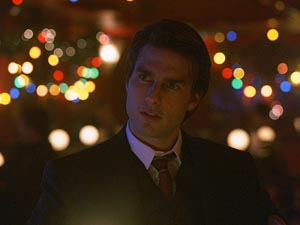 212 |
 213 |
 214 |
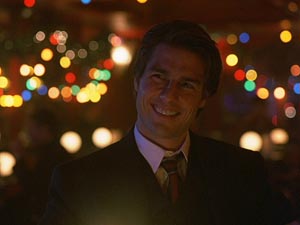 215 |
 216 |
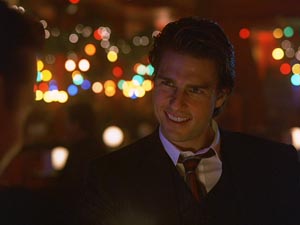 217 |
 218 |
 219 |
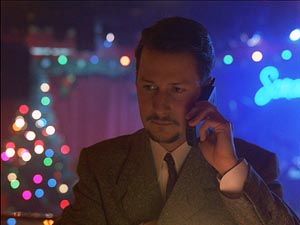 220 |
221 CU Nick writing on a napkin. (59:47)
Nick writes on the napkin. To the side rests his drink with his half slice of lime in an arch that reminds of the arch over doorway of the blue building next to the Cappuccino place where Bill had been accosted by the bullies, and the arches which we will see at Somerton.
Bill reaches out to stabilize the napkin for him. Nick writes FIDELIO.
Nick was attempting to write the "F" of Fidelio when Tom held the napkin for him as it was slipping. If one looks closely at the napkin, under the F is a figure that looks more like a "B" or a "P".
NICK: Uh-hum. Right.
222 MS Bill from Nick's right. (59:56)
NICK: Okay. Well, I'm on my way right now.
He puts away his pen. Bill, picks up the napkin and reads it.
NICK: Okay, sir. Thank you. Bye-bye.
BILL (holding up the napkin): What is this?
223 MCU Nick. (1:00:08)
NICK: It's the name of a Beethoven opera, isn't it?
224 MS Bill from Nick's right. (1:00:10)
BILL (reproving, disbelieving, putting down the napkin): Nick.
225 MCU Nick. (1:00:14)
NICK: It's the password. (Reaches to take it from Bill.)
BILL: The password.
NICK: Yeah, look. (Pockets it.) I'm really sorry to do this to you, Bill. I mean...I gotta...I gotta get going. I gotta. I gotta go.
226 MCU Bill. (1:00:30)
BILL: Nick, you know there's no way on earth that you're gonna...
227 MCU Nick from Bill's left. (1:00:40)
BILL: ...leave here tonight without taking me with you.
NICK: Oh, c'mon. Buddy, give me a brea...
BILL: Okay, Nick, I'll tell you what. I've already got...
228 MCU Bill leaning in toward Nick, from his left. (1:00:49)
BILL: ...the password. (Smiles.) Just give me the address and I'll go there...
229 MCU Nick from Bill's left. (1:00:55)
BILL: ...by myself. And there won't be any connection between us whatsoever.
NICK: Listen. Let's just say, for one second, that I was prepared to do that. You couldn't get in anyway, in those clothes.
230 MCU Bill from Nick's right. (1:01:11)
BILL (sitting back): Why not?
231 MCU Nick from Bill's left. (1:01:15)
NICK: Because everyone is always costumed and masked. And where the hell are you going to get a costume at this hour of the morning?
 221 |
 222 |
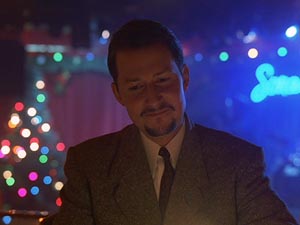 223 |
 224 |
 225 |
 226 |
 227 |
 228 |
 229 |
 230 |
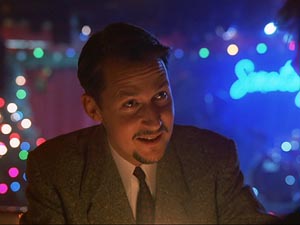 231 |
|
Again, throughout the back-and-forth dialogue we have had the blue lights backing the person with whom Bill is conversing. Instead of a blue window, which has been the source of the blue light before now, we instead have the blue neon of the Sonata Jazz sign as source.
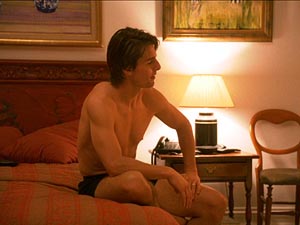 82 |
 83 |
 92 |
 93 |
 150 |
 151 |
 187 |
 188 |
 215 |
 216 |
I have already commented in section one on the word fidelio and its relationship to the (rain)bow of the covenant. Allow me to quote myself in part:
QShTh being the bow of the covenant, the rainbow, QShT or QShVT means fidelity, truth, given as corresponding to QShT, to balance, equity, reality. Again, the Art/Temperance card has all to do with balance, but we also have Bill later receiving, through Nick Nightingale, the password of Fidelio.
The screenplay instead gives the password as "fidelio rainbow" making the password itself the link between rainbow and fidelio.
Nick does have a Mephistophelean quality air to him here, aided by his style of mustache and beard. Time and again we have Bill seeming to be invited down a path and then there's the appearance of his being deterred. For instance, the initial drink with Nick at Ziegler's. For instance, when invited by Gayle and Nuala to the end of the rainbow he was interrupted by the butler and the OD of Amanda. When with Domino, he was interrupted by Alice phoning. Now, Nick is the agency by which Bill's progression down his path is ensured, Nick having provided the password. But it is a password that was likely given to him on the phone by Victor, and Nick (also meaning victory) is a kind of double or alter ego of him.
Accompanying Nick's Mephistophelean air, we have the lighting set up in such a way that his eyes are a glare of white, perhaps even a kind of shining, an effect which we also witnessed with Domino and even with Marion. This is counter what happens later with the masks, when nearly all eyes are deeply obscured by shadow--though not all are this way. So, if one notices how the eyes are lit sometimes in the scenes with Marion, Domino and Nick, one may again have the sense of something eerie, not quite right. Perhaps even of djinn.
Assuring Bill he couldn't enter in those clothes, rather than Nick imposing another obstacle, he is further aiding him with this information.
But, as we shall later see, Bill is indeed an invited guest and his reception assured.
In the book, Nick is Jewish
BILL'S FIFTH PASS THROUGH THE NEIGHBORHOOD
RAINBOW FASHIONS AS VICTOR'S SECOND FLOOR GALLERY OF BRONZE RENAISSANCE STATUES - "LOOKS LIKE LIVE" MANNEQUINS (DETAILING THEIR MOVEMENTS) - THE TWO VERSIONS OF THE DRESSING ROOM CLOSET AT THE HARFORD APARTMENT AS EXPRESSED IN THE RAINBOW OFFICE WHERE IS ALSO THE HARFORD'S RUG - THE MYTH OF THE RAINBOW, FLOOD, THE NEPHILIM AND THE MIGHTY MEN OF OLD
232 LS Bill's cab turning onto the Rainbow Costume Rental street. (1:01:25)
Cut to the street. We view at the end of the street the "Thread Mills" building advertizing sewing thread. Beside it is the Pescado. They are recognizable as the buildings at the end of the street when Bill was accosted by the Yalies. As the cab turns we see a sign for "Pitman" street.
The taxi pulls up before the Rainbow costume shop, a neon rainbow sign hanging above the door and under it painted the words "Under the Rainbow". Above is a window displaying four mannequins of men in tuxes. The number on the building is simply 10.
The inspiration for The Rainbow would appear to be an old location of Patricia Field's clothing store on East 8th Street.
The cab is 7M96. Our first certain sighting of this cab, I think, is in the scene where Domino meets Bill on the street He has stepped up to cross the street and this same cab turns in front of him, which forces Bill back and is when Domino speaks to him. But I believe it is also the cab which ferried Bill to Marion Nathanson's. It is this cab that drives him out to Somerton.
233 MS Bill paying the cab driver. (1:01:41)
Bill had formerly walked about the village so his taking the cab is new. Bill apparently must arrive at the Rainbow by cab, just as he will arrive at the Somerton mansion later in a cab, which is one of the things that ends in distinguishing him from the other party goers who are more likely to be ferried in stretch limos. Later, he is abandoned by cabs when he most requires assistance. Specifically this cab.
As Bill pays the cab driver we see beyond on the right a building that in earlier scenes had been blue and with an arch over the door. Beyond that is the vacant lot he had passed prior to being accosted by the Yalies, and beyond that is what was the hardware store before which he had met Domino, which was a grocery store he had passed before turning onto the street and seeing the Yalies. During that scene with the Yalies, the Rainbow was a cappuccino cafe with a green and white striped awning. In the scene with Domino, the Rainbow appeared as it does now though the storefront was empty and it had no Rainbow sign.
We also see another mailbox, this one in front of the cab, though the prior shot showed a mailbox behind the cab.
BILL: Thanks, keep the change.
Bill turning to climb the stairs, we are afforded a good view of the Rainbow Costume Rental sign and the Under the Rainbow store in the level beneath Rainbow Costume Rental.
Bill goes up the stairs next to the shop and rings the bell.
MILICH (on the intercom): Yes. Who is it?
BILL: Peter. This is Bill Harford. I apologize for disturbing you at this late hour but I need your help.
234 MS profile of Bill. (1:02:09)

MILICH: Who is it that you want?
BILL: Oh, I, I'm very sorry. I'm looking for Peter Grenning? The owner of Rainbow Fashions.
MILICH: What's your name?
BILL: My name is Bill Harford. I'm Mr. Grenning's doctor.
MILICH: You are Grenning's doctor?
BILL: Yes.
MILICH: Okay. Just a moment.
Rather than identifying himself as an acquaintance of Grenning, Bill uses his credentials as a doctor as his own password to get him through metaphorical (and literal) doors, and here's where we begin to become aware of it, after the introduction of the password "fidelio" at the Sonata. This is the first of Bill's productions of displaying his ID.
235 MS of the hall inside the building through the door's gate. (1:02:38)
We see in the window of the door the reflection of the street behind and in this reflection is the Sonata cafe's neon sax and the Gillespie Diner sign. Though he had ridden up in a cab, turning right onto this street, it seems Bill has only crossed the road, which will not be an error, an oversight, instead it is Kubrick using the same storefronts over and over again as a commentary on Bill's situation in a seeming maze. From what I've observed, more often than not, individuals are unaware of Kubrick reusing facades, of Bill being in the same neighborhood, until viewing these neon reflections and recognizing them, but they still don't realize the extent to which Kubrick recycled the facades.
As earlier mentioned, we had seen this building just beyond the hardware store when Domino had approached Bill, but it had been dark then. In another shot of Bill and Domino, we'd also seen the opposite side of the street, and there was no Gillespie's, no Sonata. We had also seen this building, though at that point with a green and white stripe awning, in the encounter with the frat boys who slammed Bill against a car, and above the green and white awning of the cappuccino shop was the hidden name of Sharky's coffee shop which this will become toward the end of the film.
So, Kubrick isn't simply reusing the set. He has left obvious clues as to its being only partially disguised. And one of the most obvious ones is that we're able to see here the reflection of the Sonata Cafe sax and the Diner sign in the window. Though we don't see the names, these neon symbols should be familiar to the viewer as we had just observed them prior Bill's entering the Sonata.
Seen in the glass, the signs are reversed.
Kubrick has here made these neon signs stand out so that the viewer may begin to be aware Bill is traversing the same streets time and again. This isn't a mistake. It isn't laziness. It isn't because he was reusing the set and couldn't afford to change the signs. Truly comprehending this demands that the viewer must approach Eyes Wide Shut with a different eye. Kubrick is attempting to shake the viewer out of the traditional narrative line and make them aware there is more going on than that.
We have a version of this in other Kubrick films. For instance, in Lolita it is with the the synchronous use of 242 uniting places (which Nabokov had in his book, though using a different number). Charlotte's house is number 242, and the room Humbert and Lolita stay in at the Enchanted Hunter is 242, then later Lolita performs in a play to do with an enchanted hunter. We may not be revisiting the same set but all these things are united.
Milich exits the door to his apartment and passes through the hall to the front door, tying the belt of his robe. Though he is bearded, due his features and accent and age he reminds of the Hungarian, Sandor, at the Ziegler party, but his appearance is not at all slick.
At the party, after Nick had been called away, while waiting for Bill at the bar, Alice had met the Hungarian, and Bill had been engaged by Nuala and Gayle. Milich, strongly reminiscent of Sandor, who had asked Alice up to see Victor's second floor gallery of bronze renaissance statues, is proprietor of the Rainbow with its array of mannequins. The Rainbow, a shop raised above the street level with one underneath, references perhaps that second floor to which Sandor had invited Alice for the viewing of the Renaissance bronzes.
A fun bit of humour, as Milich steps out the door we see reflected on him only the portion of Gillespies that reads "spies". An allusion to Bill's being followed? Though his being stalked supposedly begins after his visit to Somerton?
MILICH: You are looking for Peter Grenning.
236 MS Bill from Milich's left. (1:02:54)
BILL: Yes, I am.
237 MS Milich. (1:02:55)
MILICH: He moved to Chicago...
238 MS Bill from Milich's left. (1:02:58)
MILICH: ...over a year ago.
BILL: He moved to Chicago. (Laughs.) Well, I wasn't aware of that. Uh, then, are you the present owner...
The fact that Peter Grenning, who Bill knew as owning Rainbow fashions, has moved, fits in a peculiar way with what is now the Rainbow having been observed before as a vacant storefront when Bill had just met Domino.
Behind Bill we view not only Gillespie's diner, but on the right we see a red sign reading "eros". This brings in again the Cupid/Eros of the Angel's Kiss statue at Victor's.
239 MS Milich. (1:03:12)
BILL: ...of Rainbow Fashions?
MILICH: Yes, I am.
The etymology of "fashion" is interesting, considering the mannequins, as it comes from the Latin "factitius" meaning artificial.
Just thought I'd throw that in.
240 MS Bill from Milich's left. (1:03:15)
BILL: Well, first of all, please, let me apologize once again for disturbing you at this hour, Mr. uhm...
MILICH: Milich.
BILL: Mr. Milich. Just to let you know that I really am Dr. Harford, this is my New York State medical board card.
241 MS Milich looking at the ID through the gate. (1:03:29)
MILICH: Okay, so you are Dr. Harford. If I see Peter I'll tell him you were uh looking for him. (Begins to retreat.)
242 MS Bill with the Diner sign clearly evident behind him. (1:03:38)
BILL (pocketing his ID, holding out a hand to stay Milich): Oh, no, no, no, no. Wait, please, please, please. Uhm. Listen, the reason that I came here tonight was uhm basically the reason is is is that I need a costume.
243 MS Milich. (1:03:51)
BILL: And I'd be happy to pay you a hundred dollars...
244 MS Bill. (1:03:54)
BILL: ...over the rental price for the inconvenience.
245 MS Milich. (1:03:58)
MILICH: A hundred dollars.
246 MS Bill. (1:04:00)
BILL: Yes.
247 MS Milich. (1:04:02)
MILICH: I don't think so.
248 MS BILL. (1:04:06)
BILL: Well, uh, okay. How about two hundred dollars.
249 MS Milich. (1:04:10)
MILICH: Two hundred dollars? Over the rental price?
250 MS Bill. (1:04:14)
BILL: Yes.
251 MS Milich. (1:04:16)
MILICH: Okay.
 236 |
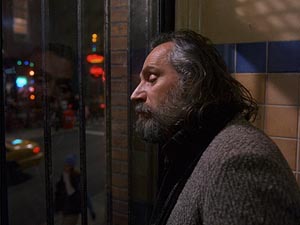 237 |
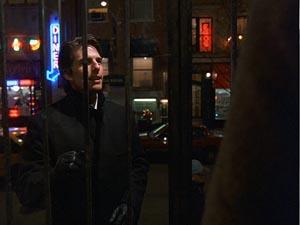 238 |
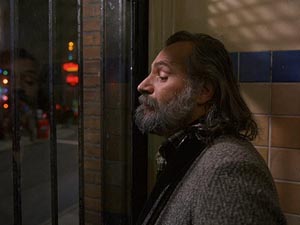 239 |
 240 |
 241 |
 242 |
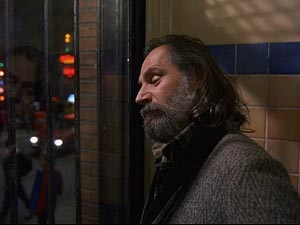 243 |
 244 |
 245 |
 246 |
 247 |
 248 |
 249 |
 250 |
 251 |
There is just enough of a resemblance between Sandor and Milich that we should be reminded of Alice's encounter at the party.
252 LS Interior of shop. (1:04:07 begin crossfade to interior of shop, ending at 1:04:20.)
We begin the crossfade with Milich agreeing to Bill's proposal, and stooping to unlock the door. The crossfade is out as Milich opens the door to the interior of the shop, the alarm warning sounding, Bill passing into a gated security enclosure with one more door yet to be unlocked.
We notice that the arrangement of the mannequins has changed from the exterior view of the shop. The positions of the mannequin in a white coat and the mannequin with the top hat have been switched.
MILICH (unlocking the door for Bill): Come in.
Bill enters and Milich goes to cut off the alarm.
MILICH: Can't be too careful these days. (Gestures to the rear counters.) Please.
The next time Bill is in the shop, where these shirts are, against the wall, will instead be shoes, and a second counter will be also located here instead of just the one before the two cases of suits along the back wall.
Bill follows Milich to the rear counter behind which Milich takes his position, cutting on a Tiffany style stained glass lamp on the counter. It seems one with a dragonfly motif.
MILICH: Is it any special costume you're looking for?
BILL (rubbing his hands against the outside cold): Yes. Uhm, I need a tux, a cloak with a hood, and a mask.
MILICH: A cloak with a hood. And a mask.
BILL: Yes.
MILICH: Okay. I think we'll find something for you. Follow me please.
Milich gestures Bill behind the counter and goes to a door between two cases of tuxes.
253 MS Bill and Milich entering the rear hall. (1:05:11)
At the end of the hall, white lights hang on the wall much like at the Ziegler party on the wall behind the stairs. Mannequins in costumes surround, many of which are masked.
MILICH (gesturing to a mannequin in the right rear corner with a parasol): Looks like live, huh?
BILL: Yes, it's wonderful.
I can't believe it's not butter. Back to the real thing as versus that which only seems real. The comment "looks like live" strikes the audience as humorous as at first glance none of this looks live, and Bill's disingenuous answer is nothing but obliging. He just wants his costume and to get out of there.
When Milich says, "Look like live..." he gestures briefly in the direction of a mannequin with a parasol. It is difficult to tell but some will, at times, appear to be live.
MILICH: So, what color cloak? Red, brown, (unintelligible)?
BILL: Black.
MILICH: Are you sure the good doctor wouldn't like something more colorful?
As in perhaps befitting a rainbow.
BILL: I don't think so.
The woman mannequin in the black mask and black dress was seen in shot 252 through the door as Bill entered this area. It has switched positions here and is further down.
As we progress down this hall, the viewer has to ask themselves, "How does this long hall begin to fit in with what we know of the shop?" It doesn't and is another very obvious stand-out clue to the viewer that the film needs to be approached in terms outside a traditional narrative founded in realism.
Milich seems intent on getting Bill to consider another style of costume.
MILICH: Clowns, officers, pirates.
BILL: No. No. Just the tux, the black cloak...
MILICH: With the hood and a mask.
BILL: Yes.
MILICH: Okay. May I take your coat?
Bill removes his cloak and Milich takes it from him. Milich has coughed several times. He asks Bill if he is a medicine doctor. We expect him to ask about his cough, but instead he inquires about his hair.
MILICH: You are medicine doctor, yes?
BILL: Yes, I am.
MILICH: Huh. Look, doctor, I have some problem (scratches his beard) with my hair, y'know. (He grabs a lock.)
BILL: Your hair.
MILICH: It's starting to fall down too fast. I lost in two weeks a lot of hair. Mostly here. Look at this. Here.
Milich bends forward and shows Bill a bald spot at the back of his head that reminds a little of a clerical tonsure. Bill, uncomfortable and eager to be elsewhere, not too keen on the idea of giving out free advice, says it's not his specialty, that Milich needs to see a tricologist, and presses for the costume.
The bald spot is of the type of tonsure belonging to the monks in the Hierophant card of the Tarot, who are presented before the Hierophant on his throne, who wears red. The Hierophant will be soon appearing in the film.
BILL: Oh, yes.
MILICH: You see?
BILL: Yes.
MILICH: And?
BILL: I'm afraid this really isn't my field.
MILICH: What? You can't help me?
BILL: You should see a tricologist. It's a hair specialist.
Milich draws an exasperated breath, placing his hands on his hips.
BILL: Mr. Milich, I've obviously left things a bit late tonight...
254 MS Bill and Milich, a glass enclosed room at the other rear of the hall behind them. (1:06:21)
Over the glassed-off room is a sign like that on the front of the building: Rainbows, Tuxedoes, Fancy Dress. Except that exterior the store the rainbow's arch is of one piece whereas here it is broken down the middle, so we have an "inbetween" as in again a possible sense of reflection.
It's a little like the inner sanctum of the inner sanctum. Yet another level of the Rainbow within the Rainbow.
BILL: ...if you don't mind.
MILICH: Okay, okay! I'm in hurry, too, doctor, to get back to bed.
He goes to the racks of clothes on the right, flinging Bill's coat on the ground. Which is pretty funny. Here, can I take your coat, and then he pitches it on the ground. But an association is perhaps being made here with the black cloaks that the women divest themselves of during the rituals, each a pile of black cloth on the floor. We don't see Bill's black coat on the ground and so the connection isn't visually made. However, when Alice and Bill were being received at Victor's party we saw a black pile of cloth behind the Christmas tree in the room with the grand staircase, and I think it's reasonable to think of that as one of the initial references to those black cloaks. Recollect that another link between the Rainbow and Victor's are the bow decorations observed in the hall after leaving the grand staircase room and proceeding to the ballroom. The Rainbow is also Sharky's and when Bill later enters it he will pass under an identical bow.
I'm going to hazard, considering that in the room of the grand staircase at Victor's there had been the strings of lights against the wall behind the staircase, and the black cloth crumpled behind the base of the Christmas tree, that this hall is a version of that room.
BILL: I understand.
MILICH: So, black cloak.
We hear a thunk.
MILICH: Did you hear something?
255 MS Bill and Milich looking to the glass enclosed room. (1:06:36)
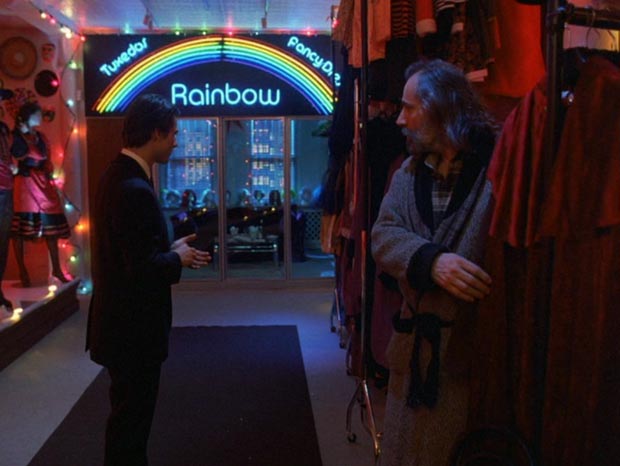
BILL: Hmm.
MILICH: What is this?
Milich advances toward the room.
256 MS Milich approaching the room. (1:06:44) Milich looks through the glass into the room.
MILICH: What is it?
Milich opens the door and enters the room. What we are seeing on the left wall, the red with the black figures, is a reflection of the two Spanish style Flamenco dancers in the gallery of costumed figures which are also against the left wall just outside the room, backed by red curtains also reflected here.
When he turns on the light we see how the red reflections of the drapes had tinted red the black cloaks hanging on the wall.
In the back room we view a purple sofa--very much the color of the upholstered chair in Victor's bathroom--draped with a camisole or negligee and a short kimono. Just as the wine colored sofa refers back to the wine colored chair in Victor's bathroom, so does the camisole/negligee remind us of the white garment that was carelessly slung over the side of the bidet.
On a table before the sofa is Chinese take-out in boxes with chopsticks. To the left are several cloaks and a green Spirit of Christmas style robe hanging from the wall with a few boas. On a long shelf to the rear are a number of wig heads draped with wigs. Above these are two windows that look out upon the impossible lights of skyscrapers, much as in Domino's apartment. As with windows in The Shining which couldn't possibly exist, neither could these, nor those at Domino's.
The archiviokubrick.it website identifies the below image as Tom and Alice's apartment.

It isn't, it is instead the exterior of Domino's, but it's interesting that they do have that identification, perhaps given at the time of the photo, and that it is paired with a wig shop, whereas the Lotto shop is in the place of the wig shop when this building is home to Domino.
An image from the Kubrick archive shows a model of Domino's building, and that model has instead the Lotto store rather than the wig shop and Domino's building seems to have initially excluded the apartments on the left side.
MILICH (looking at the food): What is this?
Milich picks up the camisole and examines it. He hears a stifled sneeze behind him and turns and tears down the green Spirit of Christmas robe so that we see behind a Japanese man in a black curly wig, unclothed except for a red jock strap. (Even when one is aware that the man is behind the robe and can see a bit of his black wig in the shadow, the curls of the wig blend texturally with the nearby feathers of the boas.) Milich tears off the wig of the Japanese individual who underneath has gray hair. He wears make-up and powder.
Below is a still of what we see as Milich turns and tears away the robe.
There is no "closet" here though there appears to be one. Instead the Japanese man will be seen standing on the floor and behind him is the wall. The appearance of a closet is aided via the reflection, for in it we observe the platform on which stand the male and female Flamenco dancers in the hall. Both reflections of these dancers are observed here. In fact, one could say that the Japanese man emerges from the reflection of the male Flamenco dancer. When Millich pulls away the robe, its white fur makes this even more apparent.
What we have here seems to connect with the two versions of clothing closets back at the Harford residence. The Alice version in the first shot of the film was raised several inches off the ground and composed of four doors.
The version we see when Bill is getting dressed appears to have the mirrors extending nearly all the way to the ground. Only three mirrored panels are seen, the fourth hidden. It is the same closet, the differences are illusory.
We are revisiting both these closets in the illusion of a closet at the Rainbow where they are merged as one.
One may recollect that in section one of the analysis I had noted that when Bill is leaving his room his reflection disappears briefly, not observed in the center mirrored panels. This is the approximate location from where the hidden Japanese man in the red underwear emerges. If we examine carefully again "Bill's" dressing room, we see behind the twin black bags in the left corner what may be some red fabric lying tucked away in the corner.
Recollect, too, that there was no throw rug in the dressing room when Alice was in there, but there was one when Bill was in there.
The rug in the dressing room with Bill is the very same rug that we observe here, in the Rainbow dressing room, under the coffee table laden with Chinese food.
I'm going to throw in here a little funky something that happens if you superimpose Alice in the dressing room with Bill in the dressing room. The three panels of the mirrors, as they were in Bill's scene, the last of them meets up with the first of the panel's in Alice's scene. (There are four panels but by a trick of perspective the fourth panel nearest Bill is entirely out of sight.)
I'll show this more clearly below by superimposing the white outlines of the mirrors from Bill's scene on Alice's scene.
If we return and look at Milich again standing before the "closet", as we have the reflections of the mannequins outside the room seemingly reflected on the "closet" (they are reflections on the intermediary glass panes), one could almost look on it as Bill's closet being the mannequins outside the room that have been pulled in and superimposed by means of the reflections. Not a very effective way of saying what I'm trying to express.
MILICH: What on earth is going on here!
JAPANESE MAN IN RED: Milich, I can explain everything.
The man's eyes drop down to the sofa alerting Milich something is down there.
MILICH (looking behind the sofa): You! What you doing here!?
A young woman appearing to be about 14 to 16 rises from behind the sofa. (In actuality she is older, but we are given the impression she is a young teen.)
MILICH: I kill you! I promised I'd kill you!
Another Japanese man stands up from behind the sofa, wearing make-up and a long blond wig. He also is almost entirely nude.
MILICH: And you! (He rips the wig off the second Japanese man.) Have you no sense of decency? (He hits the man with the wig.) Gentlemen! Have you no sense of decency!?
Earlier noted, the etymology for "doctor" traces back to decency. In conjunction with how Kubrick will now have Bill brandishing his doctor ID everywhere to gain entrance, I wouldn't be surprised if the use of the word "decency" here doesn't refer to Bill and his doctorate. These men have also gained a suggested legitimate entrance via having been invited by the "young lady", though Milich argues against this, and thus mirrors Bill's having been invited to the end of the rainbow by Gayle and Nuala, and ultimately invited to Somerton, even as the appearance is also given that his presence at Somerton is undesired. Later, when Bill returns to the Rainbow, he'll find the men are still there, some agreement having been made. But already we have the feeling Milich's aggression here is all just a show for Bill, and so would that seem to be confirmed by the men being still there later.
We can see a third figure, a clown beside the two Flamenco dancers, on Millich's back. (Recollect how Alice's bare back had served as a kind of cinema screen as she entered the ballroom area of Victor's party?) Observing this we can tell the girl is standing in a kind of "reflected" version of where she will end up in the outer hall when she flees to take refuge with Bill who is standing several feet beyond the clown in the hall.
Just for a moment, let's take a look at the idea of the threesome, which also occurs in A Clockwork Orange when Alex takes home a blond and brunette from the Chelsea record store and they have sex to the Gallop portion of The William Tell Overture. That Gallop had also ben used in The Shining when Wendy and Danny went out to explore the maze. In my analysis of A Clockwork Orange I have explored how Gillian Hills plays the blond, who is largely mute. In Antonioni's Blow Up, she was in a threesome with Hemmings and Jane Birkin. The threesome in Antonioni's film serves as a gateway to Hemming having a revelation, for it is after having had sex with him, as they dress him, he has the realization that a dead man is in one of his photos.
The threesome here seems connected with these others, and perhaps even the boas can be linked back to Alex's boa constrictor that he stored under his bed.
Of course there is also a connection to be made to Nuala and Gayle, the blond and brunette who invited Bill to the end of the rainbow.
JAPANESE MAN IN RED: Milich, are you crazy? We were invited here by the young lady.
MILICH: Young lady! This is my daughter! And couldn't you see she is a child? You will have to explain to police.
JAPANESE MAN IN RED: The police!
MILICH: You little whore, I kill you for this! I promise! I kill you! I'll kill you!
The girl races from the room as Milich grabs for her, Milich pursuing. She had wrapped the kimono about her shoulders like a shawl, which he pulls off her.
As she flees we briefly see on the left wall a monitor showing the scene.
Is this accidental or purposeful?
We are able to see Bill's reflection in the glass, which I've outlined for your ease of viewing below.
This is one long shot with no cuts. Yet as the young woman runs out of the room and past the mannequins to Bill, we see the number 101 briefly on the screen at 1:07:46. At least on the full aspect ratio version. My guess is this is perhaps only a post Kubrick fluke? I don't see it on the 2 disk special edition.
Returning to the monitor appearing on the wall opposite the "closet", in the earlier scene with Domino and Bill, Alice intruded with a phone call, and beside her was a television showing a scene from Blume in Love, a movie on a divorce lawyer's desire to win back his wife after they divorce due his having slept with another woman. In The Shining, Kubrick had television sets appearing multiple times airing shows that commented on the action. We had also in this film the Tazmanian Devil/Santa cartoon that comments on the action. The appearance of this screen here may possibly not be accidental. It may act much like when Kubrick uses other movies and cartoons for commentary. But I am also reminded of how in The Shining we have at least one very behind-the-scenes moment in which we see, opposite room 237, an open door, and beyond that open door appears be observed the bare bones of the set.
Earlier, when they were speaking on the phone together, we had the television sitting to the side of Alice corresponding with the mirror beside which Bill was standing in Domino's. Before the mirror was the book, Shadows in the Mirror. Bill had been reflected in the mirror. And here, again, we should perhaps think about this idea of the shadows in the mirror and the reflections of the mannequins and Bill barely observed in the glass of the dressing room and yet very present.
257 MCU The girl hiding behind Bill. (1:07:48)
She takes refuge behind Bill.
MILICH: Hold on to that girl for me, please!
JAPANESE MAN IN RED: Milich, this is preposterous! The young lady invited us here.
The girl looks at Bill seductively, her face made up to have a porcelain doll like transparency.
258 MS Milich in the doorway of the room. (1:07:55)
He tosses the kimono at the men.
MILICH: Couldn't you see she is deranged! (To Bill.) Doctor, I'm sorry to keep you waiting. (To the Japanese men.) Gentlemen, this is now police matter. You will please stay here until I return.
Milich exits and locks the door. The men run to the door but are unable to open it.
JAPANESE MAN IN RED: (Unintelligible). Let us out of here!
MILICH: I'm afraid it's out of the question.
He walks toward Bill and as he does so we see the clown mannequin has subtly shifted position.
MILCH: Doctor, uhm, sorry.
The magician mannequin with the large turban has been supplanted by the woman with a parasol--and she appears not to be a mannequin but a live woman. Or maybe she is just a very live-looking mannequin!
We briefly see no mannequin with the large turban in the line-up, the place where the woman with the parasol had previously been at the far end left of the line of mannequins now empty.
BILL: Uhhh....
MILICH: Black?
BILL: Black.
MILICH (to the Japanese men): Gentlemen, please, have the goodness to be quiet for the moment! Couldn't you see I try to sell my customer!? (To Bill.) Sorry. (He goes to the clothing racks, turns to yell at his daughter.) And you, little whore! Go to bed at once, you depraved creature! I deal with you as soon as I (unintelligible) gentleman!
259 MCU The girl behind Bill. (1:08:29)
The girl raises herself on her toes to whisper something in Bill's ear. We see that she wears a costume jewelry ring with a large amber color stone in a triangle shape.
GIRL: You should have a cloak like (unintelligible).
It is supposed that she says "ermine", though it's not heard. In the screenplay, she says he must have a cloak lined with ermine and a doublet of red silk. The doublet brings in the idea of doubles again, it coming from the word double.
The girl then slowly walks away, and when she nods her head and raises her eyebrows it appears as though she is being flirtatious and inviting, when instead she is nodding her head that, yes, indeed, that is the kind of cloak Bill should have, the one she just mentioned to him.
We see now in the background the magician mannequin with the large turban has taken the place where the woman with the parasol had once been. All three of the mannequins before the golden threads of lights to the rear have changed places. This, and certain other changes, would be a likely prelude to the Pook "Migrations" music that plays during the "orgy" scene at Somerton.
The female mannequin with the red shoe to the forefront has changed. Most notably her right leg is uncovered.
The clown behind her has also changed, most notably portions of his attire being now black instead of white. Previously he wore white stockings is now dressed in black stockings.
Why does the female "mannequin" wear only one shoe? I am reminded of Domino's apartment and how there was a single gold shoe prominently displayed on the presents in the bathtub. The gleaming gold "slipper" would belong to the right foot. The female mannequin wears only a shoe on her left foot.
I return to Helena's desire to stay up and watch "The Nutcracker", the plot of which involves a little girl who saves the Nutcracker prince by tossing her slipper at the Rat King with whom he is fighting. After this, the Nutcracker Prince and Clara find themselves in a pine forest. The dance of the snowflakes occurs and they journey to the Nutcracker Prince's kingdom which he had left in the care of the Snow Queen.
Subsequent Bill's visit to the Rainbow, he passes through a pine forest, but instead of snowflakes we have the opposite, Somerton (summer). At his home however, in his office, above the credenza where he will hide his mask and cloak, is the painting "Thorns and a Little More Snow".
At the Rainbow, he is surrounded by mannequins who are half-alive, some having the appearance of being played by real people, and the curious girl is made up in a later scene to have the distinct appearance of a doll. The absence of the shoe on the mannequin could place us in a story variation of "The Nutcracker", paralleling Clara's slipper tossed at the Rat King. It's difficult and probably pointless to look for an exact parallel for the Rat King, the Nutcracker and Clara. Instead, what's important is the inanimate coming to life, Bill in a gallery of an array of exotic costumes vaguely comparable to the that exotic personages which will entertain Clara in the Nutcracker Prince's kingdom. This introduces us to the later orgy where no one is unmasked but for Bill, and as no one is unmasked those individuals too can be taken as representing the inanimate having become quick and living.
Shhh! "Twas the night before Christmas and all through the house, not a creature was stirring, not even a mouse!" But there was something stirring here! What was the sound that had caught Milich's attention? Could we interpret it perhaps as having been the tossing of the shoe?
Again, Milich brought to Bill's notice a soft clunk heard which indicated something unusual, returning to the admonition of Gayle and Nuala that Bill misses much--for which reason the trip the to the end of the rainbow. He asked Bill if he'd heard it, then investigated and "found" the men. When they were admonished for being there, the men protested their right, having been invited. As I earlier noted, this is like Bill's position as one invited to the end of the rainbow and yet he will find himself scolded and punished for what he sees at Somerton.
My feeling is also that the pair of Japanese men are perhaps to be associated with the twin Chinese dragons in Victor's bathroom, which flank the fireplace there. Here, one of the men is merged with the reflection of a flamenco dancer, and often times flamenco is associated with flamingo which comes from the word flame.
Flamenco dancing is also associated with bullfighting, sometimes simulating.
The actress who plays Milich's daughter is Leelee Sobieski. As she is a Lolita figure, that Kubrick would choose a woman whose name is Leelee is interesting. All the more interesting that her name is a variant of Lily.
late 14c., flowering plant (Iris germanica), also "prismatic rock crystal," from L. iris (pl. irides) "iris of the eye, iris plant, rainbow," from Gk. iris (gen. iridos) "a rainbow; the lily; iris of the eye," originally "messenger of the gods," personified as the rainbow. The eye region was so called (early 15c. in English) for being the colored part; the Greek word was used of any brightly colored circle, "as that round the eyes of a peacock's tail" [Liddell and Scott].
So here at the Rainbow we find Lily. But the rainbow is expressed in multiple places. For instance, we find the fleur-de-lis (a symbol of the rainbow) in Lou Nathanson's bedroom and in the Harford home.
But this doll like woman-child also reminds of the etymology for the eye's pupil.
"center of the eye," 1660s (in L. form from late 14c.), from O.Fr. pupille (14c.), from L. pupilla, originally "little girl-doll," dim. of pupa "girl, doll", so called from the tiny image one sees of himself reflected in the eye of another. Gk. is said also to have used the same word, kore (lit. "girl"), to mean both "doll" and "pupil of the eye;" and cf. obsolete baby "small image of oneself in another's pupil" (1590s), source of 17c. colloquial expression to look babies "stare lovingly into another's eyes."
Her face is doll-like, but is distinguished from the mannequins on display--which move about--by not sharing in their pallor. The mannequins, moving as they do, surreptitiously as they do, impart a magical quality which will have everything to do with Bill's adventure at Somerton, but it is not the first time Kubrick has used mannequins in a disquieting manner.
Kubrick used mannequins in Killer's Kiss. The fight to the death between (good guy) Davey Gordon and (bad guy) Vincent Rapallo takes place in a warehouse filled with mannequins. They even battle with the mannequins, Davey throwing them against the axe Rapallo is wielding, the mannequins instantly dissolving into billowy clouds of dust. At the end, when Davey kills Rapallo, a cut is made to a female mannequin head, which becomes the voice of Rapallo's scream which that turns into a train whistle. In A Clockwork Orange there were the sculptures of women (mannequin-like) at the Moloko bar, some of them in bondage. But it's Kubrick's use of them in Killer's Kiss that seems more intimately related to Eyes Wide Shut, the mannequins there communicating a sense of static liveliness so that Vincent's scream even becomes confused with them.
As we are now inside Rainbow fashions, it seems appropriate to return to the myth of the flood and the rainbow.
And the Lord said, My spirit shall not always strive with man, for that he also is flesh: yet his days shall be an hundred and twenty years. There were giants (NPhL) in the earth in those days; and also after that, when the sons of God came in unto the daughters of men, and they bare children to them, the same became mighty men (GBVR) which were of old, men of renown. And God saw that the wickedness of man was great in the earth, and that every imagination (ITsR) of the thoughts of his heart was only evil continually. And it repented the Lord that he had made man on the earth, and it grieved him at his heart. And the Lord said, I will destroy man whom I have created from the face of the earth; both man, and beast, and the creeping thing, and the fowls of the air; for it repenteth me that I have made them. But Noah found grace in the eyes of the Lord. The earth also was corrupt before God, and the earth was filled with violence...And God looked upon the earth, and, behold, it was corrupt; for all flesh had corrupted his way upon the earth. And God said unto Noah, The end of all flesh is come before me...
Where we have rainbows and implied floods and talk of great big bullying guys and unbelievable women like you've never seen then, yes, I think it's reasonable to turn to the above biblical excerpt. There are numerous ideas concerning the Nephilim and there's no reason to go into them, only to look at the essence, for they are rather ambiguous entities. Orion, as I mentioned previously, is sometimes given as one of the Nephilim, the flood supposedly bringing to an end the age of heroes, just as the story of Odysseus' journey home after the Trojan War is recognized as the end of the age of heroes, Odysseus transitioning into a modern man. Before the flood, myths have it the gods interacted directly with men, and due this we have so many tales of people and things undergoing radical transformations which became the basis of so much symbolism. So many metamorphoses of the gods and due the gods, as recorded in Ovid's book, which I have already mentioned in the first part of the analysis, relating that to the many morphings in Kubrick's films. The Book of Enoch identifies the Nephilim as children of Watchers, angels sent to watch over humans but instead intermarried with them, had children, and taught them forbidden knowledge. In that light, we can look upon them as being gods such as Prometheus who gave the gift of fire and ended in being tormented for it for a period of time. Indeed, with Prometheus it wasn't only a gift of fire, but fire symbolizing a gift of knowledge. And from there one could go into discussion on the associated ideas of awakening, of having one's eyes opened, of initiation, which is what Bill is undergoing. His own manner of awakening, which is what he and Alice describe it as at film's end. That they are now awake.
The men "of old" in the biblical passage is owlam as in "concealed, the vanishing point" coming from "alam" which is "to veil from sight...blind, hide (self), secret (thing)". They stand beyond modern history.
A Watcher is iyr (OIR), coming from uwr (OVR), "a primitive root (rather identical with 'uwr' through the idea of opening the eyes); to wake (literally or figuratively)." The other uwr means to be bare, made naked. And from this comes another word for blindness through the idea of a film over the eyes.
ITsR, here expressed as the imagination, is the same as Yetzirah, the third of the four worlds of the Kabbalistic Tree of Life. It's the world of formation, as a potter working with clay. Below that is the world of Assiah which is thought of as having an upper spiritual level and then a lower one which is the physical universe. Preceding Yetzirah is the first world, Atziluth, the world of pure divinity, then the world of Beriah, which is the World of Creation.
Things are in a bit of a muddle, aren't they? What does all this mean? How does it fit together? What's really there? What's not?
The Labyrinth, between walls in the dark, Ran criss-cross a bewildering thousand ways Devised by guile, a maze insoluable, Breaking down every clue to the way out. So intricate the drill of Trojan boys Who wove the patterns of their prancing horses, Figured, in sport, retreats and skirmishes
Source: Vergil's Aeneid
BLACK AND WHITE
The clown mannequin's stockings change from back to white during this scene, and now we will have Bill traveling to the magical land of Somerton.
Killer's Kiss is an underworld rescue tale, as is Eye's Wide Shut. In it Gloria is taken captive by Vincente, the guy for whom she works as a taxi dancer. She had agreed to move with Davey, the boxer, to Seattle to start a second life. And so he goes to rescue her from Vincente but is overcome by Vincente's thugs. He pretends to be unconscious, then leaps through a window, during which the light makes it look like we have a film inversion of black and white. When he lands outside, his socks have changed from black to white. Then he battles Vincent in the land of the mannequins.
We had previously seen in Davey's dreams an inversion of black and white film, so we have a bridging of seeming "real life" and the otherwordly. In the analysis of Killer's Kiss I make a comparison with Cocteau's Orpheus in which we have a like inversion as Orpheus is transported by Death to the underworld. When Death steals Eurydice away, coupled with her smashing the mirror through which she travels with Eurydice, is Death's gown changing from black to white. In the ancient myths, Orpheus loses Eurydice despite his endeavor to retrieve her, unable to keep from looking back to see if she is following him. As soon as he does so, she vanishes. With Cocteau, Eurydice is allowed to return to life.
It's a wonderful myth. People likely envision Orpheus physically going to the underworld to rescue Eurydice. But of course that's not the case. The ancients, like us, saw bodies die, enter rigor mortis, inanimate, decay. Eurydice hadn't absented herself physically. She was dead. Stone cold dead. That dead body wasn't going anywhere except eventually being partly restored to the earth. She hadn't vanished. Orpheus' pursuit of her to the underworld wasn't a physical one. He went via another path.
Black and white inversions.
In 2001, Poole had moved his rook and then HAL had said, "I think you missed something" and proceeded to relate how he would checkmate Poole, but when he spoke of moving his Queen he related the perspective as observed from Poole's "white" side of the board instead of HAL's "black" side of the board. And this is important, that he was seeing from both points of view, in black and white.
AND INBETWEEN
I note the following in section six, but I may as well snip it and insert it here as well. A bit of introduction.
Which leads me briefly to comment on why Greenwich Village? It seems obvious--Greenwich Village with its bohemian associations, though it is instead now upscale and the artist community long gone. But I return and look at University Place and 11th Street where we have this "turning" taking place, shot 379 supposedly being in the vicinity of the Sonata Jazz club, and shot 385 supposedly being in the vicinity of the Hotel Jaso(). I wonder if Kubrick's choice has to do with longitude 0◦ 0' 00" and GMT or Greenwich Mean Time, also known as Universal Time.
1's proliferate at certain points in the film. When we see the Aleph truck, Grand Central Station is in the background. With shots 379 and 385 Kubrick ties in certain spots with University Place and 11th Street, using Bowlmor Lanes as a kind of hinge, it being at 110 University Place. After his visit at the Jaso(), Bill then returns to Rainbow Fashions. Though the establishing "real" street shot shows 131 St. Mark's Place (Paul's Da Burger Joint) and 2nd Ave., over in the East Village, we see the number 10 on Rainbow (Fashions) and 10 this time also shown a 2nd time on its gated door, which had not been observed the previous night. It is in the windows of Rainbow (Fashions) that the audience is often first alerted to the fact that the Sonata Jazz club is directly opposite the Rainbow, despite Bill traveling to the Rainbow by cab. Somewhere floating in these 1s and 10s is, one might hazard, the Universal Time, the Greenwich Mean Time, the 0◦ 0' 00" of the film and its labyrinth.
I know the above is a little confusing, because you don't have information I've given in section six. What I've posited seems far-fetched, but in The Shning Kubrick established there as well a kind of ground zero. It was the Continental Divide on which the Overlook was placed psychically, this realized through the shots made on the Going-to-the-sun Road at the film's opening and on Closing Day.
In The Shining, when the bug is going up the road during the opening it is approaching the Continental Divide from the east, and makes one skip over (in one shot) to a place on the west of the Continental Divide. Then on Closing Day, the bug is shown on the road heading east to the Continental Divide, it being on the west side, and again there is one shot in which it is shown over the Continental Divide on the other side. This is decidedly symmetrical and I think plays in with the world maze we see at the Overlook, from Jack's point of view, which is an absolutely symmetrical infinity maze extending from a central (dividing point) space. It's never said the Overlook is plotted as being on the Continental Divide in those Montana shots and doesn't have to be said. The Colorado Overlook has the symmetrical world/infinity maze and its ground zero amounts to the same.
My belief is that Kubrick chose Greenwich Village intending it to connect with the idea of Greenwich Mean Time, providing us again this implied dividing line, kind of like the chess board, and the space too between Kubrick's reversals and symmetries.
1s and 0s. We don't see the number of the locker in which the dead woman, Amanda, will be kept in the morgue, but we see the one below is #01, and we're able to deduce she is in locker #10 and locker #11 is to the right of hers.
If we look at the critical scene in The Shining in which Dick begins to shine Room 237, in which the dead woman rises from what is essentially a crypt, it is preceded by the television news showing the tower from which it broadcasts. That television news cuts on by itself, Dick doesn't cut it on, and as it continues in sunny, summery, Miami, he has his vision of what is happening back amongst the evergreens in snowy Colorado at the Overlook in room 237 where the dead woman rises.
Again, a kind of center point is being expressed. Much like the center point of the world maze. Much like the Continental Divide. Much like Greenwich Mean Time. Much like the Rainbow and its address expressed as 10 on the facade when Bill first arrives at it, and then when he returns the following day, after there is the 10 on the facade and 10 on the door.
Inbetween, Bill will now travel to Somerton, into the underworld.
MILTON KEYNES
What I have written about the "middle" of the maze/Greenwich/the Continental Divide and its relation to 0s and 1s in the film probably seems absurd, but take this also into consideration, before we embark with Bill on his trip to Somerton... there is a statue installation at Milton Keynes in Buckinghamshire (Buckinghamshire is also where the Somerton exterior was filmed) that bears a distinct resemblance to the tri-cornered hat man at Somerton.

By Philip Jackson, the statue is dated 1995.
In the next section, I note how here we are in the midst of winter, near the time of the solstice, and Bill lands in a place called Somerton. There's an interesting fact about Milton Keynes, which is a new town, a designed town. It took its name from what was once called Middleton de Keynes, eventually becoming Milton Keynes Village of Middleton civil parish. What is to me of particular interest is that when the grid for Milton Keynes was being set, Wikipedia notes that "while still on the drawing board, planners noticed that the main streets near the proposed city centre would almost frame the rising sun on Midsummer's Day. Greenwich Observatory was consulted to obtain the exact angle required at the latitude of Central Milton Keynes, and they managed to persuade the engineers to shift the grid of roads a few degrees in response."
tl;dr. I don't want to have to read something this long to have fun with a few quirky facts about the film. I don't have time for it and it all looks kind of flakey, honestly. Can't you just do some posts with titles like "10 Weird Things About Eyes Wide Shut"? Posts I can read in a minute?
I agree, sometimes it does look kind of flakey and Kubrick can get kind of weird. I think this section is key to the film, but, yeah, it's a bit of a long read and gets really involved. I empathize. Sometimes I say, "WTF, Kubrick, why?"
POSTS TO READ NEXT BEFORE CONTINUING ON TO THE SOMERTON SECTION
Whoa. Things got a bit unwieldy there for a moment. But in the following three posts they are tamed. In the first two I do some comparisons between Kubrick, the Schnitzler novel, and a 1969 production of the novel.
Read first What Happened at the Masked Ball of the 1969 Traumnovelle vs. Eyes Wide Shut.
Then read Traumnovelle, Eyes Wide Shut and the Vehmic Judges.
And lastly read The Sonata Jazz Cafe, Madame Jojo's, Number 10, The Rainbow, and Downing Street.
Then continue on to section five.
Approx 14,000 words or 28 single-spaced pages. A 107 minute read at 130 wpm.
Next: Go to Eyes Wide Shut Analysis - Part 5
Go to Table of Contents for Analysis of Eyes Wide Shut
Link to the main TOC page for all the analyses
